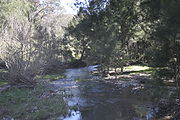
Abercrombie River
Encyclopedia


New South Wales
New South Wales is a state of :Australia, located in the east of the country. It is bordered by Queensland, Victoria and South Australia to the north, south and west respectively. To the east, the state is bordered by the Tasman Sea, which forms part of the Pacific Ocean. New South Wales...
, Australia
Australia
Australia , officially the Commonwealth of Australia, is a country in the Southern Hemisphere comprising the mainland of the Australian continent, the island of Tasmania, and numerous smaller islands in the Indian and Pacific Oceans. It is the world's sixth-largest country by total area...
, flowing from Mount Werong westward to the Wyangala Dam
Wyangala Dam
Wyangala Dam is a large water storage facility located in the southwest slopes area of New South Wales, Australia. The dam is situated below the junction of the Lachlan River and Abercrombie River. It was the second water storage project to be constructed by the Water Conservation and Irrigation...
near Cowra
Cowra, New South Wales
Cowra is a town in the Central West region of New South Wales, Australia in the Cowra Shire. It is located on the Mid-Western Highway, 317 kilometres west of Sydney on the banks of the Lachlan River at an altitude of 310 metres above sea level. At the 2006 census Cowra had a population of 8,430...
. The river is a tributary of the Lachlan
Lachlan River
- Course :The river rises in the central highland of New South Wales, part of the Great Dividing Range, 13 km east of Gunning. Its major headwaters, the Carcoar River, the Belubula River and the Abercrombie River converge near the town of Cowra. Minor tributaries include the Morongla Creek...
, which it joins at Wyangala lake.
The 130 km (80.8 mi) river flows through freehold land as well as the Abercrombie River National Park
Abercrombie River National Park
Abercrombie River National Park is a national park in New South Wales, Australia, located 138 km west of Sydney.-External links:*...
, and provides habitat for platypus
Platypus
The platypus is a semi-aquatic mammal endemic to eastern Australia, including Tasmania. Together with the four species of echidna, it is one of the five extant species of monotremes, the only mammals that lay eggs instead of giving birth to live young...
and rakali. The Goulburn-Oberon Road
Goulburn-Oberon Road
The Goulburn to Oberon Road is a New South Wales country road linking Goulburn near the Hume Highway to Oberon. The road is designated as Main Road 256 and is "seen as a future bypass of Sydney"....
crosses the Abercrombie River in the steep-sided Abercrombie Gorge.
The original inhabitants of the land alongside the river were Aborigines
Indigenous Australians
Indigenous Australians are the original inhabitants of the Australian continent and nearby islands. The Aboriginal Indigenous Australians migrated from the Indian continent around 75,000 to 100,000 years ago....
of the Wiradjuri
Wiradjuri
The Wiradjuri are an Indigenous Australian group of central New South Wales.In the 21st century, major Wiradjuri groups live in Condobolin, Peak Hill, Narrandera and Griffith...
or Gundungara clans, which may have used the river as a trading route. The first European to discover the watercourse was explorer Charles Throsby
Charles Throsby
Charles Throsby was an Australian explorer, pioneer and parliamentarian. He opened up much new land beyond the Blue Mountains for colonial settlement. He was a grazier, and became a prominent member of New South Wales society.- Early life :...
on 5 May 1819, during an expedition from Sydney to the Central West of New South Wales. Alluvial gold was discovered in and along the river in 1851, inspiring a minor gold rush
Gold rush
A gold rush is a period of feverish migration of workers to an area that has had a dramatic discovery of gold. Major gold rushes took place in the 19th century in Australia, Brazil, Canada, South Africa, and the United States, while smaller gold rushes took place elsewhere.In the 19th and early...
hampered by the ruggedness of the terrain and the periodic depths of the waterway. Early miners recovered up to 3 oz (85 g) of gold a day along the river, and by 1862 between forty and fifty mining parties were at work at Milburne Creek, a minor tributary of the Abercrombie.
It is the furthest east of the inland flowing rivers.

